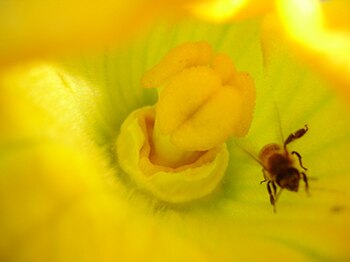Squash, pumpkins and zucchini are all members of the same plant genus, Cucurbita, along with cucumbers, watermelons and gourds. They grow on vines. Technically they are fruit, not vegetables at all. However, they are often treated as vegetables in the kitchen.
Growing Squash
 |
| Squash growing on vine. (Photo credit: Wikipedia) |
A sunny corner of the vegetable garden is a good place for growing squash, pumpkins and zucchini. You can train the vines to grow out of the vegetable bed so that they do not take over too much of your precious composted soil. If you have more than one plant, they should be at least two feet apart, depending on the variety.
Water them regularly but do not allow the ground to become waterlogged. Harvest them when the vines that they are growing on start to become dry and shriveled.
Growing Pumpkins
Pumpkins are native to North America which is part of the reason why they have become so strongly identified with American traditions like Halloween and Thanksgiving. They will grow pretty much anywhere in the States except for Alaska. They prefer slightly acidic soil, pH 6.0 to 6.8.
Pumpkins like warm weather. In most climates you can plant in June or July for harvest in the fall. They like a certain amount of water but not too much. If the ground is too wet, the fruit can rot. On the other hand if the soil is very sandy or there is not enough water, the fruit will not grow well.
Growing Zucchini Or Courgettes
Zucchini is a summer squash thought to have originated in Italy. It is less sweet than pumpkins and most winter squashes and belongs to a different family in the same genus. The name 'zucchini' is used in North America and Australia and comes from the Italian (plural in Italian, but used for both singular and plural in English). The French name 'courgette' is used in all other English-speaking countries. Both 'zucchini' and 'courgette' mean 'small pumpkin'.
 |
| Zucchini flower being pollinated by a honey bee (Photo credit: Wikipedia) |
One or two starter plants is enough for most gardens. You can grow them from seed and plant out as seedlings. They should have three months of frost-free growth outdoors when daytime temperatures are warm but not scorching hot.
Zucchini can grow to 2-3 feet long but they are usually harvested at around 8 inches when immature. If left to grow too long they become more fibrous and the seeds become harder.
Growing squash, pumpkins and zucchini relies on good pollination. This is naturally done by bees but if the bee population is not numerous in your area, you can help it along by hand pollination. Insufficient pollination will result in fruit that does not develop properly.
No comments:
Post a Comment